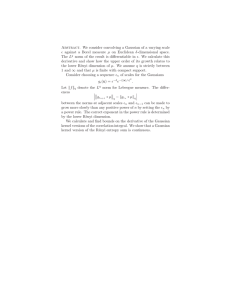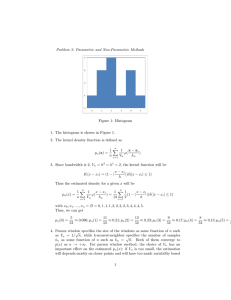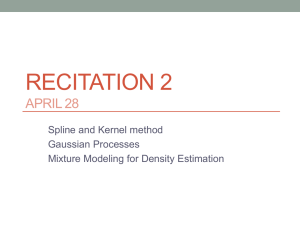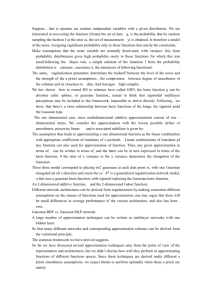Bayes Meets Bellman: The Gaussian Process
advertisement
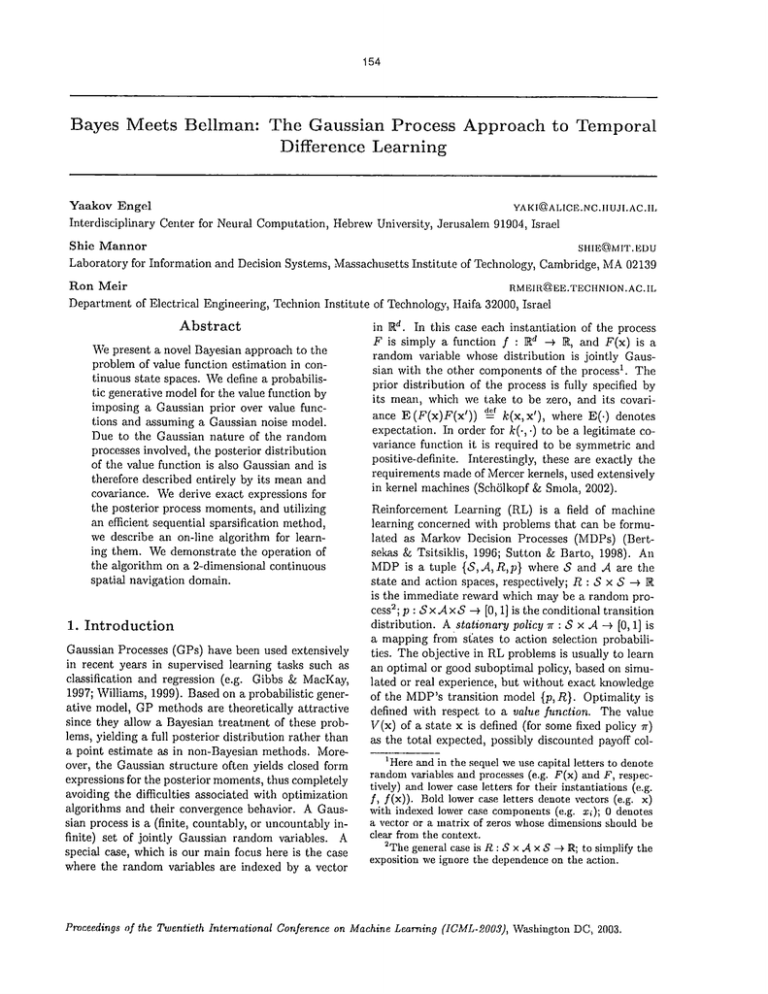
154
Bayes Meets Bellman:
Yaakov Engel
Interdisciplinary
The Gaussian Process
Difference Learning
Approach to Temporal
YAKI~AL1CE.NC.IIUJI.AC.IL
Center for Neural Computation, HebrewUniversity, Jerusalem 91904, Israel
Shie Mannor
Laboratory for Information and Decision Systems, Massachusetts Institute
SHIE~.MIT. EDU
of Technology, Cambridge, MA02139
Ron Melr
RMEIR~--~EE.TECtlNION.AC.
IL
Departmentof Electrical Engineering, TechnionInstitute of Technology,IIaifa 32000, Israel
Abstract
Wepresent a novel Bayesian approach to the
problem of value function estimation in continuous state spaces. Wedefine a probabilistic generative modelfor the value function by
imposing a Gaussian prior over value functions and assuming a Gaussian noise model.
Due to the Gaussian nature of the random
processes involved, the posterior distribution
of the value function is also Gaussian and is
therefore described entirely by its meanand
covariance. Wederive exact expressions for
the posterior process moments,and utilizing
an efficient sequential sparsification method,
we describe an on-line algorithm for learning them. Wedemonstrate the operation of
the algorithm on a 2-dimensional continuous
spatial navigation domain.
1. Introduction
Gaussian Processes (GPs) have been used extensively
in recent years in supervised learning tasks such as
classification and regression (e.g. Gibbs &MacKay,
1997; Williams, 1999). Based on a probabilistic generative model, GPmethodsare theoretically attractive
since they allow a Bayesian treatment of these problems, yielding a full posterior distribution rather than
a point estimate as in non-Bayesian methods. Moreover, the Ganssian structure often yields closed form
expressions for the posterior moments,thus completely
avoiding the difficulties associated with optimization
algorithms and their convergence behavior. A Gaussian process is a (finite, countably, or uncountablyinfinite) set of jointly Gaussian randomvariables.
special case, which is our main focus here is the case
where the random variables are indexed by a vector
in ~d. In this case each instantiation of the process
F is simply a function f : li~ d --+ I~, and F(x) is
random variable whose distribution is jointly Gaussian with the other components of the process1. The
prior distribution of the process is fully specified by
its mean, which we take to be zero, and its covariance E(F(x)F(x’)) d~f k(x,x’), where E(.)
expectation. In order for k(., .) to be a legitimate covariance function it is required to be symmetric and
positive-definite. Interestingly, these are exactly the
requirements made of Mercer kernels, used extensively
in kernel machines (Sch61kopf & Smola, 2002).
Reinforcement Learning (RL) is a field of machine
learning concerned ~dth problems that can be formulated as Markov Decision Processes (MDPs) (Bertsekas & Tsitsiklis, 1996; Sutton & Barto, 1998). An
MDPis a tuple {S,A,R,p} where S and A are the
state and action spaces, respectively; R : S x S --+ L~
is the immediate reward which may be a random process2; p : S x A× S --> [0, 1] is the conditionaltransition
distribution. A stationary policy 7r : S × A ~ [0, 1] is
a mappingfrom st’ares to action selection probabilities. The objective in RLproblemsis usually to learn
an optimal or good suboptimal policy, based on simulated or real experience, but without exact knowledge
of the MDP’stransition model {p,R}. Optimality is
defined with respect to a value function. The value
V(x) of a state x is defined (for somefixed policy
as the total expected, possibly discounted payoff colXHereand in the sequel weuse capital letters to denote
randomvariables and processes (e.g. F(x) and F, respectively) and lowercase letters for their instantiations (e.g.
f, f(x)). Bold lower case letters denote vectors (e.g.
with indexed lower case components(e.g. xi); 0 denotes
a vector or a matrix of zeros whosedimensionsshould be
clear fromthe context.
2Thegeneral case is/g : S x Ax S --r R; to simplifythe
exposition we ignore the dependenceon the action.
Proceedingsof the Twentieth International Conferenceon MachineLearning (ICML-2003),WashingtonDC,2003.
155
leered along trajectories starting at that state 3. The
value function of a policy ~r is defined as
V(x) = E (fi 7tR(xt’xt+l)’x°
’ t =o
(1.1)
where the expectation is taken over the policy dependent state transition
distribution
p~(xqx)
~.~c~p(x’lu, x)~r(ulx). Here 7 e [0, 1] is a discount
factor 4, and/~(xt, xt+l) is the expected reward.
The value function can be shownto be the solution to
the Bellmanequation, which should be satisfied for all
s,
xE2d
which normally requires on-line operation. As fax
as we are aware the only exception is Dietterich and
~¥ang(2001) in which the value function is estimated
off-line using a support vector machine.
The rest of the paper is organized as follows. In the
following section we present our generative modelfor
the value function and derive the exact posterior value
distribution. In Section 3 we describe our on-line sparsification method;Section 4 unifies the results of the
two preceding sections in the description of an on-line
sparse algorithm for GP temporal difference (GPTD)
learning. In Section 5 we present experiments with
GPTDon continuous 2-dimensional mazes, and we
conclude in Section 6.
V(x) = fx, exP~(X’[X)(/~(x,x ’) +TV(x’))dx’. (1.2)
2.
If the state space is finite the integral in Eq. (1.2)
replaced by a sum over x’ C 2(. Generally speaking, RLis concerned with finding a policy r* delivering the highest possible total payoff from each state.
Manyalgorithms for solving this problem are based on
the policy iteration method, in which the value function must be estimated for a sequenceof fixed policies,
makingvalue estimation a crucial algorithmic component. Undoubtedly, the best knownmethod for value
estimation is a family of algorithms knownas TD(A)
(Sutton, 1988) which utilize temporal differences
makeon-line updates to their estimate 9 of the value
function. The simplest memberof the TD(,~) family
is TD(0). The TD(0) update at the transition from
to xt+l is simply
~(xt)
(~1~
:= 9(xt)
= rt
¯
+r/tSt
"~V(Xt+I)
, where
--
?)(xt)
is the 1-step temporal difference at time t, rt is the
reward sampled in the transition and ~t is a time dependent learning rate.
Up to now, kernel methods have been largely ignored
in the field of RL. This is due to two reasons. First
and foremost, kernel algorithms generally scale superlinearly in the number of samples, both in terms of
space and time. Second, most of these algorithms require random and/or repeated access to training samples. For these reasons, kernel algorithms, GPs included, were considered ill-fitting
to the RLdomain
SThevalue should strictly be denoted as V~; however,
since mostof this paperdeals with a fixed policy (with the
exceptionof Section 5), weretain the simpler notation V.
¯ 4.When3’ = 1 the policy mustbe proper, see Bertsekas
and Tsitsiklis (1996).
5Thisis a degeneratespecial case of the Bellmanequation which results from our problem statement, namely
evaluatingthe value functionof a fixed policy.
Gaussian
Processes
for
TD Learning
In analogy to GP regression we impose a Ganssian
prior overvalue functions,i.e., V ..~ A/’(0, k(., .)), which
means that V is a GPfor which, a priori, E(V(x))
and E(V(x)V(x’)) = k(x,x’) for all x,x’
form of the function k should reflect our prior knowledge concerning the similarity of states in the domain at hand. Recalling the definition of the temporal
differences (1.3), we propose the following generative
model for the sequence of rewards corresponding to
the trajectory Xl, x2,. ¯ ¯, xt:
-R(xi, x~+l) = Y(xi) - 7Y(xi+l) + Y(xi)
where N is a white Gaussian noise process that does
not depend on V but may be input dependent, i.e.,
N ,,~ iV’(0, ~) with ~(x,x’) = ao(x)26(x - x’),
denotes the Dirac delta function. To simplify matters we will assumethat ao (x) is constant over ,Y and
denote it simply by ao. Eq. (2.4) may be viewed as
latent variable modelin which the value process plays
the role of the latent or hidden variable while the reward process plays the role of the observable output
variable. For a finite trajectory of length t we define
the (finite dimensional) randomprocesses
=
v, =
-*
,R(x,))
V(x,)),
-r
Nt=(N(xl),..., N(x,))
,
(2.5)
and the vector and matrices (respectively)
k,(x)
k(x,, x)),
Kt = [kt(xl),..., kt(xt)]
E]t = diag(ao2,..., a2),
(2.6)
where diag(.) denotes a diagonal matrix whose diagonal is the argumentvector. Using these definitions we
156
may write
Nt
0
0
Et
(2.4). Equating the expressions for V(xi) from these
two equations we get
(2.7)
Defining the (t- 1) x t matrix
1
0
0
+
-7
1
0
-7
...
...
0
0
0
...
1
-7
H
t
(2.8)
we maywrite (2.4) concisely
Rt-1 ---- HtVt-F Nt-1 ¯
Using standard results on jointly
variables (Scharf, 1991) we obtain
(2.9)
Ganssian random
Rt-1
v(x) )
0
Et-t
and the posterior distribution of the value at some
point x, conditioned on the observed sequence of rewards rt-! = (rl .... ,rt_l) T is given by
(V(x)[Rt_1 = rt-1) -.~ Af {~t(x),pt(x)}
(2.10)
where
~t(x)
pt(x)
with Qt
and k==
f
The expressions above can be written in a somewhat
more familiar way, by separating the input dependent
term kt(x) from the learned terms:
vt (x) = kt (x) Tat, Pt (X) kzz - kt(x)T Ctkt(x),
(2.12)
where c~t = Ht-I-Qtrt-1
and Ct = H/QtHt.
While this concludes the derivation of the value GP
posterior, there are several points worth noting. First,
note that in addition to the value estimate ’St (x) we are
provided with an uncertainty measure pt(x) for that
estimate. This opens the way to a wide range of possibilities, someof which we touch upon in Section 6.
Second, the assumptions we make on the noise process
N seem to be questionable. Let us consider the validity of these assumptions. The value process satisfies
the Bellman equation (1.2) while we assume the model
-
-
x’))dx’.
Whenstate transitions axe deterministic p~(x’[x)
5(x~- xi+l), the first integral ~lishes and we are left
with
N(xi) [~(xl, xi+l) - R(xi, X/ q-l) ,
which
is
exact
if
~
R(x, x’)
Af{/~(x,x’),a02(x)} Vx, x’. As the state transitions move away from determinicity this equality
turns into an approximation. In Section 5 we experimentally demonstrate the effect of non-deterministic
transitions on the value estimate.
Finally, we note that computingthe exact GPestimators is computationallyunfeasible in all but the smallest and simplest domains, since we need to compute
and store (~t (t x 1) and Ct (t x t), incurring a
of O(t3) time and O(t2) space (The O(ts) dependence
arises from inverting the matrix Qt). In the following
section we describe an efficient on-line sparsification
method that reduces this computational burden to a
level that allows us to computea good approximation
of the GPposterior on-line.
3. On-Line
= kt(x)TH~qtrt_l,
= k==- kt(x)TH+t qtHtkt(x)
= (HtKtH/+ Et_l) -1 ,
= k(x,x).
(2.11)
-
-
f
N(xi)
Sparsification
In order to render the algorithm described above practical we need to reduce the computational burden associated with the computationof the functions ~)t and
Pt in (2.11). In Engel et al. (2002) an on-line spaxsification methodfor kernel algorithms was proposed
in the context of Support Vector Regression. This
method is based on the following observation: Due
to Mercer’s Theoremthe kernel function k(.,.) may
be viewedas an inner product in a high (possibly infinite) dimensional Hilbert space 7-t (see Schhlkopf
Smola, 2002 for details). This meansthat there exists
a generally non-linear mapping¢ : X --+ ?-I for which
(¢(x),¢(x’)} n = k(x,x’). Although the dimension
of 7/ maybe exceedingly high, the effective dimensionality of the manifold spanned by the set of vectors {¢(xi)}~=1 is at most t, and maybe significantly
lower. Consequently, any expression describable as a
linear combinationof these vectors maybe expressed,
to arbitrary accuracy, by a smaller set of linearly independent feature vectors which approximately span this
6.
manifold
~Basedon similar ideas, several other sparsification algorithmshave beenpreviouslyproposed,e.g. Burges,1996;
157
Taking advantage of this insight we maintain a dictionary of samples that suffice to approximateany training sample (in feature space) up to some predefined
accuracy threshold. Our method starts with an empty
dictionary :Do = {}. It observes the sequence of states
xi,x2,.., one state at a time, and admits xt into the
dictionary only if its feature space image ¢(xt) cannot be approximatedsufficiently well by combiningthe
images of states already in :Dt-i = {.~i,...,~m,_,}.
Given the set of mt-i linearly independent feature
vectors corresponding to the dictionary states at time
t - 1, {¢(xj)}j=, , we seek the least squares approximation of ¢(xt) in terms of this set. It can be easily
verified that this approximation is given by the solution to the following quadratic problem:
m~n {aTI~t_la - 2aTkt-l(xt)
+ ku}, (3.13)
where I~t-1 is the kernel matrix of the dictionary
states atime t-1 (i.e., [I~t-i]i,j = k(~i,~j) with i,j =
T
1,...,mr-i),
kt-l(x) = (k(xi,x),...,k(xm,_,,x))
and ktt = k(xt,xt). The solution to (3.13) at =
I~t_iii’Ct_l(Xt) and substituting it back to (3.13)
obtain the minimal squared error incurred by the approximation,
8t -- ]gtt-kt-1 (xt)Tat ---- ktt-]<$-I (xt)TI~t__llkt-1(xt).
(3.14)
If St > v, where v is an accuracy threshold parameter,
T
we add xt to the dictionary and we set at -- (0,..., 1)
since Yt is exactly represented by itself. If st _< v
the dictionary remains unchanged. Either way we are
assured that all the feature vectors corresponding to
states seen until time t can be approximated by the
dictionary at time t with a maximum
squared error v,
rrt~
¢(x~) = Ea~,j¢(:~j)
Defining the matrices ~ [At]ij = aij, ’~t =
[¢(xi),...,¢(xt)],
’I)~ ’es = [¢~es,...,¢[es] we
maywrite Eq. (3.15) for all time-steps up to t, concisely as
Ct = ~,,A: + ~’e’.
(3.17)
By pre-multiplying (3.17) with its transpose we obtain
a decomposition of the full t x t kernel matrix Kt =
@tT@tinto two matrices"
es
Kt , = AtktA[
where I~t = ~:~t. The matrix AtI~:tA~ is a rank
mt approximation of Kt. It can be shown that the
norm of the residual matrix K~e8 is bounded above
by a factor linear in v. Consequently we make the
following approximations:
Kt ~ AtITQAT, kt(x) w., A~kt(x).
I~t
=
kt-1
4.
T
l-&t]
whereat = I~t-_iik~-i(x~).
Notethatat equalsthe
vector
at computed
in solving
(3.13),
so thereis
needto recompute
it.
GPTD
t(x) =
pt(x) = k==- f,t(x)S tf, t(x), (4.20)
where we define
I=It= HtAt ,
=
+
=
,
= H tH,.
kit
’(3"16
K~-i-= st1[E~I~.J
i_a[+&ta:
On-Line
Weare now ready to combine the ideas developed in
the last two sections. Substituting the approximations
(3.19) into the exact GPsolution (2.12) we obtain
+ ¢~es, where IlCresH 2 < v.
(x/)
(3.19)
The symbol ~ implies that the difference between the
two sides of the equation is O(v). Wenote that the
computational cost per time step of this sparsification
algorithm is O(m~) which, assuming mt does not depend asymptotically on t, is independent of times, allowing this algorithm to operate on-line. Our on-line
version of the GPTDalgorithm draws its computational leverage from the low rank approximation provided by this sparsification algorithm. In the next section we show how.
j-----1
(3.15)
In order to be able to compute at at each time step,
we need to update I~t i whenever the dictionary is
appended with a new state. This is done via the partitioned matrix inversion formula (Scharf, 1991):
(3.18)
+ K[
,
(4.21)
Note that the parameters we axe required to store and
update in order to evaluate the posterior mean and
7Dueto the sequential nature of the algorithm, for j >
[At]~,i = O.
SWecan boundmt under mild assumptions on the kernel and the space 2d, however space does not allow us
Smola
& Bartlett,
2001;Williams
& Seeger,
2001;Csat6
&
Opper,
2001,
tomention
a few.However,
allbutthelatter to pursue this and other interesting issues concerningour
sparsification methodany further here.
areinapplicable
totheon-line
setting.
mi,
158
where
covariance are now 6t and Ct whose dimensions are
mtx 1 and rnt x mr, respectively. Wewill now derive
recursive update formulas for 5q and Ct. At each time
step t we maybe faced with either one of the following
twocases. Either 7:) t = 7:)t_1 or 7)t = 7:)t-1 U{xt}.
Case 1. 7:)t = ©t-l: Hence I~t = I~t-1,
Aktt a~_{aT_l
(A~{t_ 1 --
3’~,_l(X/)
) .}_3’2kit,
De-
noting gt = a~ + Aktt - Al<Tt_lCt_lAkt_~ and using
again the partitioned matrix inversion formula we get
1 stQt-1
[
5-~t = -z-st -gt~
+gtg[
-gt
1
with gt as before. Defining at = ~It-lgt
can now compute &t and Ct:
]
- at-i, we
Defining ht = at-t - 3"at,
(4.24)
Tfi[ :t-1fit + ooJ]"
Defining Afq_1 ~ Kt-lflt = l~t-t (xt-t) - 3"f¢t-t(xt),
we get
]
y }’ttZA~:t-1
(I-"It-lA]{t-1)
Jr" 0.2 J ’
Weobtain (~t using the partitioned matrix inversion
formula.
1 [ stQt-l+gtg[
-gt ]
rQ t = s~ - g -t
’
1
wheregt = Qt-jI:-It_lAkt_l,
st = 0.~ - c/Al<t_l and
ct = Ht-tgt - hr. Let us now compute at.
_ 1 [i:i[_ 1 ~t] [ stQt_l +gtg-[ lgt
=a,-1+8t
¯
8t
¯
(4.23)
Case 2. Dt = T~t-1 U {xt}: Here, I~t is given by
(3.16). Furthermore, at = (0,..., 1) T since ¢(xt)
exactly representable by itself; therefore
At
= T
0
]
’
a~-t
"
-3’
Going through the algebra we get
qtl =
t-I
(I=It-iAkt-i)
T Aktt + 02
=
Ct-1 + -Kctct
ct
(4.25)
At any point in time (say t) we can computethe prediction for the value and its variance at somearbitrary
state x using the analog of (2.12):
9t(x) = l{t(x)-C&t, pt(x) kzz - l{,(x)TCtl~t(x) ¯
(4.26)
Note that the Akt’_l~t_~ -rt-t term appearing in the
update rules for &t (4.22) and (4.24) is (up to a
the temporal difference 5t-~ defined in (1.3). Another
point worth noting is that evaluating ~)t(x) and pt(x)
costs only O(rnt) and O(rn~t) time, respectively. Table
1 outlines the algorithm is pseudo-code.
So far we have described the on-line GPTDalgorithm
for infinite horizon discounted problems.It is straightforward to modify the algorithm to handle episodic
tasks. In this kind of tasks the learning agent’s experience is composedof a series of learning episodes
or trials. At the beginning of each trial the agent
is normally placed at a random starting position and
then follows sometrajectory until it reaches one of the
absorbing terminal states (i.e., having a zero outgoing transition probability), and whose value is fixed
to zero. Algorithmically,all that is required is to ternporarily set 3" to zero whena goMstate is reached, and
makea zero-reward transition to the starting point of
the next trial. The extension to semi-Markovdecision processes, where transitions mayrequire different
amountsof time, is also possible.
(4.22)
Similarly, we get
Ct = Ct-1 + l--ctc[
Ct
5. Experiments
’
In this section we present several experiments meant
to demonstrate the strengths and weaknesses of the
159
Table 1. The On-Line GPTDAlgorithm
Parameters: v, ao, 7
Initialize: Dt = {x~}, &~= 0, (31 = 0, I~l 1 ~--- 1/kn
for ~ = 2, 3,...
Observetransition: xt, rt-x
Sparsification test:
if ¢, > v (3.14) %add x, to dictionary
ComputeI~71 (3.16)
Compute&t, C~(4.24,4.25)
else % dictionary unchanged
Compute~t, (~ (4.22,4.23)
GPTDalgorithm. We start with a simple maze in
order to demonstrate GPTD’sability to provide an
uncertainty measure for the value estimate, and its
data efficiency, i.e. its ability to extract reasonable
value maps from very little data. Wethen move beyond value estimation to the more challenging task
of learning the optimal policy (or a good approximation thereof). Weuse a more difficult maze and experiment with both deterministic and stochastic state
transitions.
Our experimental test-bed is a continuous 2dimensional square world with unit-length sides. An
agent roaming this world maybe located at any point,
but can perform only a finite numberof actions. The
actions are 0.l-long steps in one of the 8 major compass
winds, with an added Gaussian noise with a standard
deviation of 0.05. Timeis also discrete t = 1, 2,3, ....
In this world there may be one or more rectangular
goal regions and possibly also obstacles - piecewiselinear curves, which the agent cannot cross. As long as
the agent is not in a goal region it receives a rewardof
-1 per time-step. Uponreaching a goal state the agent
is given a zero reward and is then placed at somerandomstate to begin a new trial.
Webegin with a simple experiment. The maze, shown
in Fig. 1, has a single goal region stretching the entire length of the south wall of the maze(from y=0 to
y=0.1). We chose the non-homogeneous polynomial
kernel k(x,x’) = ((x, t) +1) 5, which corresponds to
features that are monomialsof up to degree 5 in the coordinates (SchSlkopf & Smola, 2002), and subtracted
0.5 from each coordinate to avoid any asymmetricbias.
The exploration policy is a stochastic one in which a
southward moveis taken with probability 0.8, otherwise a random moveis performed. In Fig. 1 we show
the results after a single trial in which12 states were
visited including a final goal state. This exampleillustrates the efficiency of the algorithm whenthe kernel
function is chosen judiciously. As can be seen at the
bottomof Fig. 1 a single policy iteration sweep(i.e.,
choosing the greedy action with respect to the value
function estimate) extracts a near-optimal policy for
a large section of the mazesurrounding the states visited. Lookingat the variance mapit can be seen that
in the proximity of the visited states the uncertainty
in the value prediction is significantly lower than in
other regions.
As we mentioned in the introduction, a value function estimation algorithm is usually a component in
a larger RLsystem whose aim is to learn the optimal
policy, namely, the one maximizing the total payoff
per trial, or in our case, the one minimizingthe time
it takes the agent to reach a goal region. Onesuch RL
algorithm that has workedsurprisingly well in certain
domains (e.g. Tesanro, 1995), although it possess
theoretical guarantees for convergence, is Optimistic
Policy Iteration (OPI) (Bertsekas &Tsitsildis, 1996).
In OPI the agent does not follow a fixed stationary
policy; instead, at each time step it utilizes a modelof
its environmentand its current value estimate to guess
the expected payoff for each of the actions available to
it. It then greedily chooses the highest ranking action.
Weran an agent utilizing OPI on the maze shown in
Fig. 2 for 100 trials, once with deterministic transitions, and a second time with the noisy transitions
described above. The kernel we used here was Gaussian k(x,x’) = exp ([[x - x’[[2/(2a2)), where ak
The feature space induced by this choice is infinitedimensional (SchSlkopf & Smola, 2002). The value
maps learned madtheir corresponding greedy policies
are shown in Fig. 2. Note that while the policies
learned are both similar and quite close to optimal,
the value estimates are different. More specifically,
the value estimates in the stochastic case seem to be
dampened. The variance maps are omitted, since over
the entire mazethe variance estimate is close to zero.
6. Discussion
Wepresented a novel temporal difference learning algorithm based on Gaussian processes and an efficient
sparsification scheme. Using these two essential ingredients we were able to suggest a practical and efficient
methodfor value function approximation in large and
eveninfinite state spaces.
Several approaches to RL in continuous space were
considered to date, mostly using parametric function
approximation architecture that are usually employed
160
Value
Value
.-.,t-.
~E-- ~
--+--
0.4
0
0
0.I 0.2 0.3 0.4 0.5 0.6 0.7 0.8 0.9
I
Value
Variance
0.8
0
,
0.1 0.2 03
,
,
~
\
i
0.4 0.5 0.6 0.7 0.8 0.9
Polic
~1--\\I111
| i i
I ¢ l
111
111
I11
111
I11
1;I
I
II
i
I
~N I
i
I i
~1 I
I-1
11111
;1111
Ilill
I1111
11111
11i1¢
liill
NNI
i
~1
1
1
I
|
l
t
I
I
I
I|
tt
lll~tlll/
I1
li
;I
~11111/
11
ill
II1|
||II1~
Figure 1. Theresults of a single 12-step trial on the simple
mazeshown in the figures, sampled on a 30 by 30 grid.
Fromtop to bottom: Top - the points visited during the
trial and contourlin~ of the value fimction estimate. Center - The variance of the value estimates. Bottom - A
greedy policy with respect to the value estimate.
Figure 2. Theresults after 100 trials on the moredifficult
maze showIl in the figures. GPTDwith OPI is used to
find a llear-optimal policy. Theuppertwo figures showthe
results for deterministic state transition while the lower two
for stochastic ones. For each pair the final value function
is shownat the top and its correspondinggreedy policy at
the bottom. The results shown are samples over a 30 by
30 grid.
161
in conjunction with gradient based learning rules (e.g.
Neural networks, CMACs,see Bertsekas and Tsitsiklis
(1996); Sutton and Barto (1998) for a review). In
architectures one must choose the complexity (i.e., the
number of tunable parameters) of the model a priori.
Other approximation methods include fuzzy sets, hard
and soft state aggregation, and non-parametric methods such as variable resolution, instance-based learning, viscosity solutions (Munos, 2000) and local averaging (Ormoneit & Sen, 2002) (We refer the reader
Sutton and Barto (1998) for a review of all but the
last two of these methods).
Our approach is fundamentally
different
from the
above. We postulate a probabilistic
generative model
for the value and use Bayesian analysis to extract
a posterior
model. Moreover, our approach is nonparametric - the complexity of the value representation (the size of the dictionary) is adapted on-line
match the task at hand. Our method goes beyond Reinforcement Learning and can be also applied to solve
control problem when the dynamics are known but difficult to capture. Specifically, our method can replace
discretization
based methods (see, e.g. Rust, 1997 and
references therein),
A significant
advantage of the Gaussian process approach is that an error estimate is provided at no extra cost. Apart from the benefit of having confidence
intervals for the value estimate, there are several other
ways in which this may be put into use. For instance,
the RL agent may use this information to actively direct its exploration (see Dearden et al., 1998); another
possibility would be to use the confidence measure to
provide stopping conditions for trials in episodic tasks,
as suggested by Bertsekas and Tsitsildis (1996).
There are several natural directions for future research.
First, an extension of GPTDto GPTD(A)is called for.
Weconjecture that such aa extension will help alleviate the problems experienced with GPTDin stochastic
environments. Second, as mentioned above, we plan to
test new RL methods that make use of the value uncertainty measure provided by GPTD. Third, we would
like to establish convergence guarantees in the spirit
of Tsitsiklis
and Van-Roy (1997). Finally, we aim
reliably solving the complete RL problem, i.e., finding
the optimal policy. This may be achieved using an
Actor-Critic architecture (Sutton & Barto, 1998).
Acknowledgments The authors
are grateful
to N.
Shimkin and I. Menache for helpful discussions.
S.M.
was partially
supported by the MIT-Merrill Lynch
Partnership.
References
Bertsekas, D., g~ Tsitsiklis, J. (1996). Neuro-dynamicprogramming. Athena Scientific.
Burges, C. J. C. (1996). Simplified support vector decision rules. Proceedings of the Thirteenth International
Conference on Machine Learning (pp. 71-77).
Csat6, L., & Opper, M. (2001). Sparse representation for
Gaussian process models. Advances in Neural Information Processing Systems 13 (pp. 444-450).
Dearden, R., ~iedman, N., & Russell, S. J. (1998).
Bayesian Q-Learning. Proceedings of the Fifteenth National Conference on Artificial Intelligence (pp. 761768).
Dietterich, T. G., & Wang,X. (2001). Batch value function
approximation via support vectors. Advances in Neural
Information Processing Systems 14 (pp. 1491-1498).
Engel, Y., Mannor, S., & Meir, R. (2002). Sparse online
greedy support vector regression. 13th European Conference on Machine Learning (pp. 84-96).
Gibbs, M., & MacKay,D. (1997). Efficient
of Gaussian processes. Draft.
implementation
Munos, R. (2000). A study of reinforcement learning
the continuous case by the meansof viscosity solutions.
Machine Learning, 40, 265-299.
Ormoneit, D., & Sen, S. (2002). Kernel-based reinforcement learning. Machine Learning, ~9~ 161-178.
Rust, J. (1997). Using randomization to break the curse
dimensionality. Econometrica, 65, 487-516.
Scharf, L. L. (1991). Statistical signal processing. AddisonWesley.
Sch61kopf~B., & Smola, A. J. (2002). Learning with kernels. MITPress.
Smola, A. J., & Bartlett, P. L. (2001). Sparse greedy Gaussian process regression. Advances in Neural Information
Processing Systems 13 (pp. 619-625).
Sutton, R. (1988). Learning to predict by the methods
temporal differences. Machine Learning, 3, 9-44.
Sutton, R., & Barto, A. (1998). Reinforcement learning.
MIT Press.
Tesauro, G. (1995). Temporal difference learning and TDGa.mmon. Comm. ACId, 38, 58-68.
Tsitsiklis,
J. N., & Van-Roy, B. (1997). An analysis
temporal-difference learning with function approximation. IEEE Trans. on Automatic Control, ~2, 674-690.
Williams, C. (1999). Prediction with Ganssian processes: from linear regression to linear prediction and
beyond. Learning in Graphical Models. Cambridge, Massachusetts.
Williams, C., & Seeger, M. (2001). Using the NystrSm
method to speed up kernel machines. Advances in Neural
Information Processing Systems 13 (pp. 682-688).


